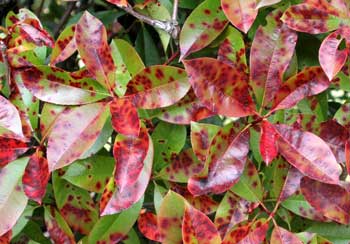Redtip Photinia
Nashville, Ark. – If you plan to plant them, prepare to spray diligently with a fungicide from bud break until leaves are fully mature. Keeping the fallen leaves all raked and burned is a must. This shrub may look beautiful, but it can and will be a lot of work. Photinia leaf spot, caused by the fungus Entomosporium mespili, is a widespread and damaging disease on the popular ornamental shrub, redtip photinia (Photinia x fraseri). The Indian hawthorn (Raphiolepisis indica) and some pear cultivars (Pyrus sp.) are also susceptible to this disease. The disease is most destructive during cool, wet weather and when active growth is occurring.
The first symptoms of photinia leaf spot are tiny, circular, bright red spots which appear on both the upper and lower leaf surfaces. Numerous spots may coalesce into large purple blotches. Mature leaf spots develop a gray center. Black specks within the spot represent the spore producing bodies of the fungus. The leaf spot will have a distinctive dark red to purple margin. Similar spots also develop on leaf petioles and stem tissues during cool, wet periods when the fungus is most active. Extensive leaf drop, which may result from severe infections, can lead to eventual plant death.
The fungus overwinters in infected leaves and shoots from the previous year. These are important sources for future disease outbreaks. Masses of spores are produced and released from the spots from late winter through spring. Spore dispersal slows during hot, dry periods Fungal spores are mainly spread by splashing water. New leaf spots may appear 10 to 14 days after infection during warm, wet conditions in the spring. On photinia, the reddish new flush of leaves is the most susceptible. Infections often start at the bottom portions of the plant and move upwards during cool, rainy periods. Practices that encourage a flush of succulent growth, such as summer pruning, frequent pruning and fertilization, often favor disease development. Presently, there are no resistant selections of retip photinia to photinia leaf spot. Chinese and Japanese photinia tend to be less susceptible than the red tip photinia. Levels of resistance are available in Indian hawthorn cultivars.
When planting, purchase only plants with no leaf symptoms. Provide adequate spacing between plants and avoid overhead irrigation to minimize leaf wetness. Remove and destroy fallen diseased leaves. Avoid overfertilization and watering which may stimulate lush growth and reduce pruning during the summer which promotes new growth. It may be necessary to remove severely infected plants and replace with a less susceptible species. Plants with a history of leaf spot may require protectant fungicidal sprays in early spring. Routine preventative fungicide applications may be required to maintain healthy specimens in the landscape. Fungicide choices include materials with the active ingredients of cholorothalonil, myclobutanil, propiconazole, triforine and triadimefon. Multiple applications may be necessary, beginning at bud break until all new foliage is matured. Fungicide sprays in combination with sanitation are needed to maintain healthy plants.
For more information, you can visit www.uaex.uada.edu, or send an email to skroll@uada.edu. Howard County Extension office is still working and is there for all the residents in Howard County during this time.
By Samantha Kroll
County Extension Agent - Agriculture
The Cooperative Extension Service
U of A System Division of Agriculture
Media Contact: Samantha Kroll
County Extension Agent - Agriculture
U of A Division of Agriculture
Cooperative Extension Service
421 N. Main Nashville AR 71852
(870) 845-7517
skroll@uada.edu
Related Links
The Arkansas Cooperative Extension Service is an equal opportunity institution. If
you require a reasonable accommodation to participate or need materials in another
format, please contact your County Extension office (or other appropriate office)
as soon as possible. Dial 711 for Arkansas Relay.
Pursuant to 7 CFR § 15.3, the University of Arkansas System Division of Agriculture
offers all its Extension and Research programs and services (including employment)
without regard to race, color, sex, national origin, religion, age, disability, marital
or veteran status, genetic information, sexual preference, pregnancy or any other
legally protected status, and is an equal opportunity institution.
